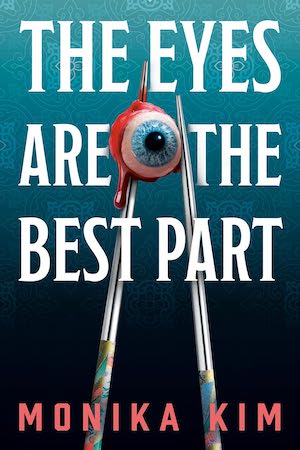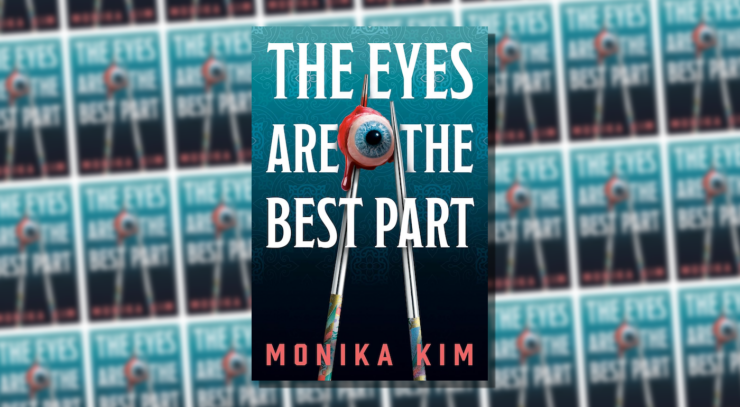Asian cuisine is often dismissed by the West as exotic and weird, and eating fish eyes easily falls into that category. In many different Asian cultures though, fish eyes are a delicacy and usually saved for honored guests because it’s believed that eating them will bring you luck. But for those who grew up in a white-centric Western world, this is usually seen as disgusting—a sentiment that is shared by Jiwon, our protagonist in The Eyes Are the Best Part by Monika Kim.
Jiwon is a young Korean-American college student whose life has been upended when her father leaves her mother for another woman. Her umma is understandably distraught and her sister is upset and confused, both looking to Jiwon for comfort and stability. But Jiwon does not feel equipped to be the emotional support they are both looking for. Reeling from the reality that she did not get into UC Berkeley like her high school best friends, Jiwon is struggling to pass her classes and make new friends at her local college. Vulnerable and unsettled herself, the sight of her mother’s despair and deep depression is unbearable to witness. So at dinner one night, when her mother offers her one of the fish eyes to eat with such hopeful anticipation, knowing how happy it will make her, Jiwon acquiesces. Surprisingly, this ignites a deep hunger and craving for them. And then, she starts dreaming…
Her dreams, or nightmares really, are harrowing, but also fascinating. Jiwon finds herself in a room full of eyes, blue eyes to be specific, just like the eye color of her mom’s new white, obnoxious boyfriend, George. She is ravenous, her hunger unsatisfied until she tastes the eyeball in her mouth. The more she dreams, the more we, as readers, become intertwined into Jiwon’s precarious psyche and her descent into madness, a decline that is exacerbated when George moves in. Feeling out of control at home with her mom’s new boyfriend living with them, Jiwon becomes more agitated, but things start looking up when she meets a new friend at school, Geoffrey, who seems so nice and smart, and eager to be her friend.
Buy the Book


The Eyes Are the Best Part
In reality, though, Geoffrey and George are really just two sides of the same coin. George is your conservative alpha male who drives a truck with a sticker that reads “I’m Republican Because We Can’t All Be On Welfare” and openly ogles young Asian women, including Jiwon and her sister. Geoffrey, on the other hand, is your typical lit bro—a young, woke college student who reads We Are All Feminists and quotes RGB. Different flavors, but the same tired dish we’ve all tasted (and sent back). If both characters sound ridiculous, it’s because they are. The themes and criticisms they embody are obvious, so much so that I assumed and applauded it as satire, because it was laughable at how ridiculous but believable these white men were. Both caricatures of toxic white masculinity, they were not complex characters, but rather simple and plain manifestations of white men who did not deserve the grace of elaboration. Having been put in boxes my whole life by men like them, it was refreshing to see the two be whittled down to flat, uninteresting characters with no depth. Kim’s decision to do so sparked immense joy in me and then proceeded to ignite my rage.
The female rage that is centered in this book comes from a real place and runs deep. It wasn’t that long ago, during the COVID-19 pandemic in 2021, when anti-Asian violence and rhetoric were at an all-time high; we saw six Asian women murdered at a spa in Atlanta all because one white man who had a sex addiction wanted to get rid of his “temptation”. But violence against and fetishization of Asian women goes back much farther than that, all the way to the 1880s. Before the Chinese Exclusion Act, there was the Page Act preventing Chinese women from immigrating due to “immoral reasons”—they were being singled out as prostitutes. To reduce the number of Chinese immigrants “infiltrating” white America, Chinese women became scapegoats and victims of both racism and sexism. So in a world where Asian women are fetishized and thus ultimately stripped of their humanity, the female rage we see in Eyes does not feel like Jiwon’s alone, but ours. For any woman, Asian or not, who has been objectified, the rage belongs to us. And for that, I cheered for Jiwon.
Jiwon loves her family and cares for them in the way she knows how. She yearns for comfort and stability. She recognizes kindness and offers it as well. She does her best to meet the expectations of being the eldest daughter; though it feels overwhelming, it is her palja (fate). But Jiwon also lies often and feels little remorse when violating the trust and rights of others, even those close to her. She feels deeply for herself, but has a hard time empathizing. Through Jiwon, Kim pushes our understanding and biases of what a “good Asian girl” is well out of our comfort zone and into the realm of psychopathy that is usually dominated by white men. If eating fish eyes is supposed to bring you luck, then Jiwon shows us that eating blue human eyes brought power. And it’ was’s this reversal of roles and power dynamic between our Asian female main character and the two white men that I thought was, dare I say, quite appetizing.
Don’t get me wrong, this book is not perfect. The themes are obvious; if you don’t take it as satire, it could feel a bit crude. The ending feels rushed and convoluted with plot holes, a definite red flag for those who want neat explanations. Personally, I didn’t mind the heavy-handed themes or the plot holes, but I did wish for more complexity in Jiwon’s mother. As the eldest daughter of Korean immigrants, I wanted to explore more of her experience as a first-generation Korean immigrant, the origins of her very apparent codependent tendencies, and how they ultimately affected Jiwon as the eldest daughter.
Kim’s social commentary on racism, sexism and the intersectionality of that as an Asian American woman is not groundbreaking. These are all tropes we’ve seen before, in books, film, and as a Korean-American woman, for me, in real life every day, battling stereotypes thrust upon me by white men. Our experience is not and should not only be in response to the white male gaze, but the focus of female rage in the book was so satisfying, I could not keep myself from smiling until the very last page.
Reading this book was similar to my own experience with eating fish eyes—a little weird and uncomfortable, but a fun ride.
To the author, jal meokkesseumnida.
The Eyes Are the Best Part is published by Erewhon Books.
Read an excerpt.










